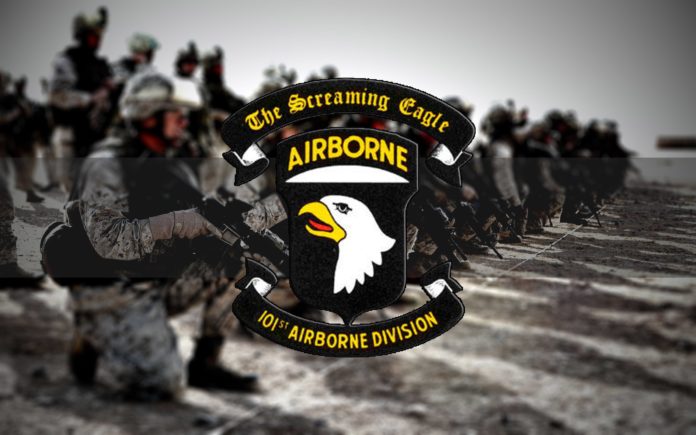The 101st Airborne Division was one of the units that defended Bastogne from a Nazi attack in World War II. Now, 78 years later, 4700 members, a new generation of airmobile soldiers, are playing war in Romania near the border with Ukraine.
CBS News is out with a psyops special report:
The 2nd Brigade Combat Team consists of the following units:
- Headquarters Company
- 1st Battalion, 502nd Infantry Regiment (“First Strike”)
- 2nd Battalion, 502d Infantry Regiment (“Strike Force”)
- 1st Battalion, 26th Infantry Regiment (“Blue Spaders”)
- 1st Squadron, 75th Cavalry Regiment (“Widowmakers”)
- 1st Battalion, 320th FAR (“Top Guns”)
- 39th BEB (“Raptor”)
- 526th BSB (“Best by Performance”)
Note that these guys replaced the 82nd Airborne Division, so this was not then and is not now a new deployment of U.S. troops. Moreover, these troops have been in place for a little more than four months:
Elements of the 101st Airborne Division (Air Assault) began arriving to the Mihail Kogalniceanum Airbase in Romania June 20, and are scheduled to continue arriving during the next several days.
Headquarters, 101st Airborne Division (Air Assault) and the 2nd Brigade Combat Team, will support the U.S. Army V Corps’ mission to reinforce NATO’s eastern flank and engage in multinational exercises with partners across the European continent in order to reassure allies and deter further Russian aggression.
The deploying 101st Soldiers do not represent additional U.S. forces in Europe, but are taking the place of Soldiers assigned to 82nd Airborne Division Headquarters and the 3rd Infantry Brigade Combat Team of the 82nd Airborne Division.
In all, approximately 4,700 Soldiers from the 101st Airborne Division are scheduled to deploy to locations across Europe.
https://www.army.mil/article/258008/101st_airborne_division_arrives_in_europe_to_support_nato_allies
It is important to understand that the 101st is “light infantry”:
Light infantry refers to certain types of lightly equipped infantry throughout history. They have a more mobile or fluid function than other types of infantry, such as heavy infantry or line infantry. Historically, light infantry often fought as scouts, raiders, and skirmishers. These are loose formations that fight ahead of the main army to harass, delay, disrupt supply lines, engage the enemy’s own skirmishing forces, and generally “soften up” an enemy before the main battle. Light infantrymen were also often responsible for screening the main body of a military formation.
https://en.wikipedia.org/wiki/Light_infantry
The 101st is essentially a band aid. Its primary mission is to try to slow up an attacking army. In other words, the 101st is an expensive, lethal speed bump. The challenge for the 101st Brigade Combat Team is figuring out how to fight a peer army. Frankly, it would be a suicide mission to deploy these guys to Ukraine. The 101st lacks the offensive punch to go toe-to-toe with a Russian heavy infantry unit.
Andrei Martyanov has the proper perspective on the capabilities of the 101st:
2. The deployment of 4,700 US paratroopers to Romania is risible even against the realities of a single operational direction of SMO theater, which sees currently about the same weekly number of casualties (KIAs, MIAs and wounded) of VSU and no American officer or soldier ever faced such combat realities in their life. Nor did US Army ever face the level of attrition VSU faces today. It is simply outside of America’s military experience. What will be the duration of combat stability–that is the ability to perform combat tasks while sustaining attrition–of the 101st under present fire impact conditions one can only speculate, but I would say at best–two-three weeks.
3. But then, of course, comes this other issue which Brigadier General John Lubas misunderstands–the only way 101st can “enter” Ukraine is under the condition of an all out war of NATO against Russia, which will require even in conventional (non-nuclear, that is) framework something between 500,000 to 700,000 NATO ground troops for the first “wave”–an impossible task for NATO and the US, unless NATO goes into full draft and I am sure American public will meet this news with enthusiasm and resolve. This, BTW, is the thinking of Mr. Petraeus, who never won shit in his life, yet somehow became a general. He thinks about “multinational” force now–I am sure his stellar experiences in Afghanistan will also be studied (already are) around the world on how not to fight COIN, forget real combined arms operations of scale of which he has only vague understanding.
Is NATO foolish enough to try to massively reinforce Ukrainian troops if Russia stages a major breakout? Here is the reality–the 101st alone is not a sufficient force and NATO would require MONTHS–let me reiterate that point–MONTHS to round up and deploy the thousands of troops that would be required to pose a credible threat to a Russian advance. Do you think Russia will sit idly doing nothing while NATO scrambles to assemble a force to invade Ukraine and challenge Russia? Ain’t going to happen.
I agree with Andrei’s observation that Secretary of Defense Lloyd Austin’s first call to Russia’s Shoigu since May was probably to reassure the Russians that the reports coming out about the 101st Airborne Division element in Romania was hype and that the United States had no intention of deploying that unit to Ukraine. The CBS report target audience is the American public. Keep feeding them bullshit in a desperate attempt to convince them that America should be fighting in Ukraine. I do not think most Americans have the stomach for another feckless foreign military misadventure.


